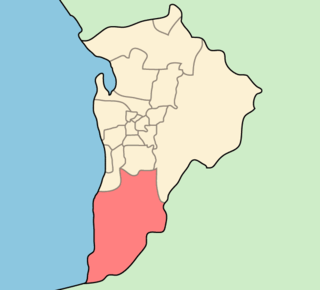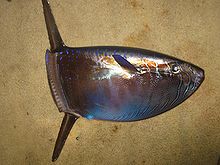
The Tetraodontiformes are an order of highly derived ray-finned fish, also called the Plectognathi. Sometimes these are classified as a suborder of the order Perciformes. The Tetraodontiformes are represented by 10 extant families and at least 349 species overall; most are marine and dwell in and around tropical coral reefs, but a few species are found in freshwater streams and estuaries. They have no close relatives, and descend from a line of coral-dwelling species that emerged around 80 million years ago.

The ocean sunfish or common mola is one of the largest bony fish in the world. It was misidentified as the heaviest bony fish, which was actually a different species, Mola alexandrini. Adults typically weigh between 247 and 1,000 kg. The species belongs to the Mola genus, one of three in the Molidae family. It is native to tropical and temperate waters around the world. It resembles a fish head without a tail, and its main body is flattened laterally. Sunfish can be as tall as they are long when their dorsal and ventral fins are extended.

Shepherd's beaked whale, also commonly called Tasman's beaked whale or simply the Tasman whale, is a cetacean of the family Ziphiidae and the only species in the genus Tasmacetus. The whale has not been studied extensively. Only four confirmed at sea sightings have been made and 42 strandings recorded. It was first known to science in 1937, being named by W. R. B. Oliver after George Shepherd, curator of the Wanganui Museum, who collected the type specimen near Ohawe on the south Taranaki coast of New Zealand's North Island, in 1933.

The false killer whale is a species of oceanic dolphin that is the only extant representative of the genus Pseudorca. It is found in oceans worldwide but mainly in tropical regions. It was first described in 1846 as a species of porpoise based on a skull, which was revised when the first carcasses were observed in 1861. The name "false killer whale" comes from having a skull similar to the orca, or killer whale.

The melon-headed whale, also known less commonly as the electra dolphin, little killer whale, or many-toothed blackfish, is a toothed whale of the oceanic dolphin family (Delphinidae). The common name is derived from the head shape. Melon-headed whales are widely distributed throughout deep tropical and subtropical waters worldwide, but they are rarely encountered at sea. They are found near shore mostly around oceanic islands, such as Hawaii, French Polynesia, and the Philippines.

The southern right whale dolphin is a small and slender species of cetacean, found in cool waters of the Southern Hemisphere. It is one of two species of right whale dolphin. This genus is characterized by the lack of a dorsal fin. The other species, the northern right whale dolphin, is found in deep oceans of the Northern Hemisphere and has a different pigmentation pattern than the southern right whale dolphin.

Cetacean stranding, commonly known as beaching, is a phenomenon in which whales and dolphins strand themselves on land, usually on a beach. Beached whales often die due to dehydration, collapsing under their own weight, or drowning when high tide covers the blowhole. Cetacean stranding has occurred since before recorded history.

The Molidae comprise the family of the molas or ocean sunfishes, unusual fish whose bodies come to an end just behind the dorsal and anal fins, giving them a "half-fish" appearance. They are also the largest of the ray-finned bony fish, with the southern sunfish, Mola alexandrini, recorded at 4.6 m (15 ft) in length and 2,744 kg (6,049 lb) in weight.

Opahs, also commonly known as moonfish, sunfish, kingfish, and redfin ocean pan are large, colorful, deep-bodied pelagic lampriform fishes comprising the small family Lampridae.

The City of Onkaparinga is a local government area (LGA) located on the southern fringe of Adelaide, South Australia. It is named after the Onkaparinga River, whose name comes from Ngangkiparinga, a Kaurna word meaning women's river. It is the largest LGA in South Australia, with a population of over 170,000 people in both urban and rural communities and is also geographically expansive, encompassing an area of 518.3 km2. The council is headquartered in the Noarlunga Centre with area offices situated in Aberfoyle Park, Woodcroft and Willunga.

Torquigener is a genus of pufferfishes native to the Indian and Pacific oceans. Males of at least two Torquigener species are known to make elaborate circular nests on the seafloor.

The yellowfin whiting, also known as the western sand whiting or fine-scaled whiting, is a species of inshore marine fish in the smelt-whiting family Sillaginidae. The species is endemic to the eastern Indian Ocean, ranging from Dampier, Western Australia to Gulf St Vincent in South Australia, with an apparent division in the populations of the two states. Yellowfin whiting inhabit relatively shallow waters for their entire life, often found on tidal flats and creeks, as well as large estuaries. It is one of the largest members of the smelt-whiting family, growing to 42 cm, and can be distinguished by a number of anatomical and colour related features. Yellowfin whiting are benthic carnivores, preying predominantly on polychaete worms, with minor amounts of copepods, amphipods and bivalves also commonly taken. The species shows a change in diet with age, and also dietary differences with other sillaginids presumably to minimize competition. Reproduction occurs at different times throughout its range, generally focused around summer, with up to 217,000 eggs produced per season. Yellowfin whiting reach sexual maturity at around 20 cm, with each individual spawning more than once. The species forms the basis of major fisheries in both Shark Bay, Western Australia and the two Gulfs of South Australia, with around 260 tonnes of fish taken each year. They are also a popular target for shore based anglers, with a reputation as a very good table fish.

The sharptail mola is a species of mola found circumglobally in tropical and temperate waters. It is similar in appearance to the ocean sunfish, but can be distinguished by the projection on its clavus (pseudo-tail). Other common names include sharpfin sunfish, point-tailed sunfish, and trunkfish. Rarely encountered, very little is known of the biology or life history of the sharptail mola. It has recently become important to commercial fisheries operating off eastern Taiwan. This species is the only member of its genus.

The giant sunfish or bumphead sunfish, , is a fish belonging to the family Molidae. It is closely related to the more widely known Mola mola, and is found in the Southern Hemisphere. With a specimen found dead near the Azores in 2021 weighing in at 2744 kg it is the largest extant bony fish species in terms of maximum recorded mass by a wide margin. It can be found basking on its side occasionally near the surface, which is thought to be used to re-heat themselves after diving in cold water for prey, recharge their oxygen stores, and attract gulls to free them of parasites.

Carybdea murrayana Haeckel, 1880, also previously known as Carybdea branchi, the South African box jellyfish, is a venomous species of cnidarian, in the small family Carybdeidae within the class Cubozoa.

Mola tecta, the hoodwinker sunfish, belongs to the family Molidae and genus Mola. It is closely related to the more widely known ocean sunfish. The Latin word "tecta" means hidden. The word "hidden" was adopted for the name because the fish has blended in among other species of sunfish for a long time and has only been discovered recently. Discovered on a beach near Christchurch, New Zealand, in 2015, it was the first new species of sunfish to be identified in 130 years. Mola tecta are mostly discovered in the temperate region of the Southern Hemisphere in the water near Australia, New Zealand, Southern Chile and Southern Africa. It was first described by Marianne Nyegaard, a marine scientist who studied ocean sunfish for her PhD.
Marianne Nyegaard is a Danish marine biologist who specializes in the study of ocean sunfish. She is known for identifying the ocean sunfish species Mola tecta.
Abu El-Regal and El-Moselhy. 2013. The first record of slender sunfish, Ranzania laevis from the Red Sea. Journal of Fish Biology. Journal of Fish Biology 83(5):1425-9



















